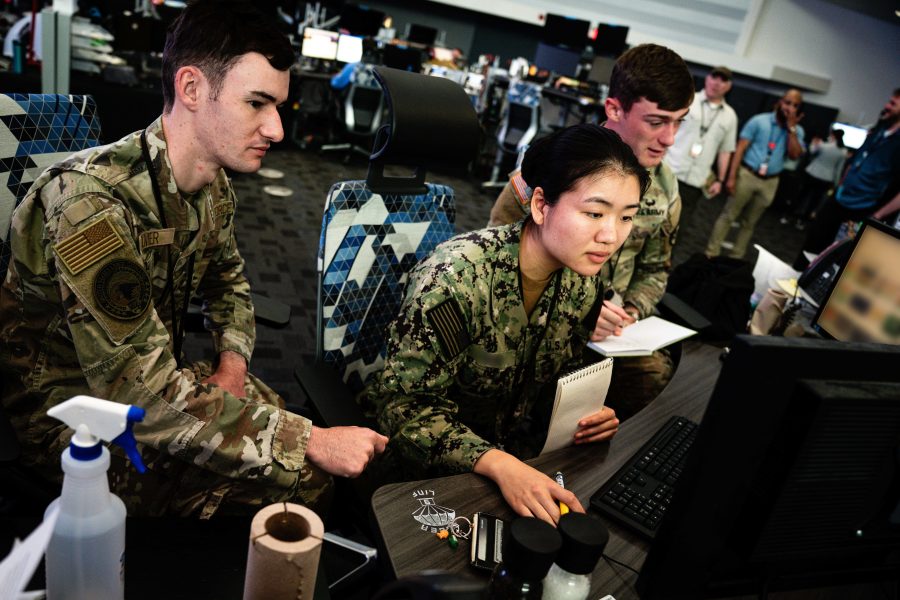The Pentagon needs a Digital Command and a Digital Warfare Corps, along with other changes, to take advantage of critical new technologies, according to a think tank founded by former Google CEO and Chairman Eric Schmidt.
How the U.S. military takes advantage of innovation in three fields in particular—sensors, AI and autonomy—will determine if it can maintain its technological advantage over China and other potential adversaries and offset their greater numbers of personnel and equipment, leaders from the Special Competitive Studies Project argue in a new report titled “Offset X Evolved.”
Key to SCSP’s proposed strategy is recognizing that these technologies each play off and feed into the others, said James Ryseff, defense director at SCSP and one of the lead authors of the report, published Sept. 18.
“People talk about sensors and data, AI, and autonomy in silos,” Ryseff said at a launch event hosted by the Defense Writers’ Group. Better data from more effective sensors like synthetic aperture radar satellites, which can see through rain and fog, creates an information advantage. Artificial intelligence can organize and analyze that data and present commanders with options more quickly than any human staff team, meaning decisions can be made faster and better. And autonomous weapons platforms can execute those decisions at a speed and scale no conventional force can match: The prized lethality advantage.
“We have to think of these three things as sort of interconnected gears that each turns the others, as opposed to isolated silos that we can pursue independently,” said Ryseff.
Such an approach would let the U.S. “counter People’s Liberation Army’s strengths without engaging in a costly and risky attempt at a symmetrical arms race or escalation,” states the report. “Rather than trying to overmatch China ship-for-ship or missile-for-missile, the U.S. can invest in capabilities that undermine the foundation of China’s anti-access/area denial and information dominance strategies.”
To execute that strategy and truly treat the sensors, AI, and autonomy as a whole, the report authors argue the Pentagon needs to establish new organizations:
- U.S. Digital Command, to take over the role of U.S. Cyber Command and also take charge of information and influence operations and electronic warfare—helping control the flow of data through sensors and AI systems and onto autonomous systems.
- U.S. Digital Warfare Corps, essentially a new service branch with its own command structure to staff Digital Command and provide technological capabilities to other commands. SCSP Vice President for Policy Ylber Bajraktari compared the arrangement to how the U.S. Space Force military service presents forces to U.S. Space Command, the operational command, though Bajraktari noted that “the analogy is imperfect.”
- Joint Warfighting and Innovation Command, responsible for modernizing and transforming the joint force to fight the wars of today and tomorrow and bringing together “concept development, resourcing, and innovation under one roof, with a singular focus on winning the next war.”
SCSP also recommends one percent of U.S. defense spending be set aside for a special innovation fund, initially controlled by the Secretary of Defense in close consultation with the Chairman of the Joint Chiefs of Staff, but later to make up the budget for the Joint Warfighting and Innovation Command.
The strategy is designed to echo that pursued by the U.S. during the Cold War, when it countered a large manpower disadvantage with Warsaw Pact troops in Europe through precision guided weapons and superior airpower.
Yet the strategic context is also different now, said Bajraktari, and it’s even changed since Russia’s full-scale invasion of Ukraine in 2022. “We have a new era that’s much more confrontational, rather than competitive” between the U.S. and its great power rivals, Russia and China, he said. The situation is complicated because of the emergence of a “coalescing axis of disruptors” including Iran and North Korea alongside Russia and China. “We don’t argue that this is an alliance in the traditional sense,” he said, but there was “cooperation on capabilities, sharing of resources and other assistance that they provide to each other, diplomatically, informationally and militarily.”
Importantly, the fulcrum of strategic power is shifting, the authors argue, tilting away from the side with the largest weapons stockpiles and towards the side best able to “evolve and adapt its military equipment and its ability to quickly scale up” the production and deployment of innovative systems. “The weapons a nation can produce before the conflict ends have as much value as the weapons they possess at its start. This is now the decisive measurement of a country’s strategic depth,” the report states.
For the Air Force in particular, the proposed strategy would have big implications, Ryseff told Air & Space Forces Magazine by email.
“Mass matters—not only in the form of more manned fighters and bombers, but in scalable fleets of drones and autonomous systems that can overwhelm adversary defenses, and preserve precious human pilots for critical missions,” he said, calling on DOD to “adopt a production mindset: prioritizing speed, cost efficiency, and scale in building evolving technologies, rather than assuming platforms will remain relevant for decades.”
In the three transformative technologies the report highlights, he said, “the ability to produce quickly, update constantly, and replace rapidly will prove far more decisive than long-term sustainment of exquisite systems.”
He said the report “also highlights the urgent need for the Air Force to build tighter feedback loops between operators and engineers so that lessons from the field translate into software and hardware updates within days, not years.”


